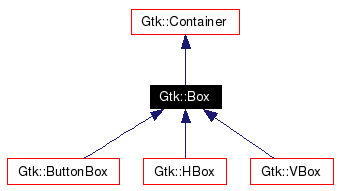
|
gtkmm: |
The C++ Interface to Gtk+ |
Boxes |

Almost everything layout-wise comes down to putting your widgets in a box.
reorder_child() method to move
children around.
This example shows how widgets (in this case, buttons) can be packed into boxes and laid out in a pleasing manner. It uses the following enumeration:
| PACK_SHRINK | Space is contracted to the child widget size. |
| PACK_EXPAND_PADDING | Space is expanded, with extra space filled with padding. |
| PACK_EXPAND_WIDGET | Space is expanded, with extra space filled by increasing the child widget size. |
You pack a widget into a box using the pack_start() or
pack_end() method.

main.cc:
#include <iostream>
#include <gtkmm/main.h>
#include "examplewindow.h"
int main(int argc, char *argv[])
{
Gtk::Main main_instance(argc, argv);
if(argc != 2)
{
std::cerr << "usage: packbox num, where num is 1, 2, or 3." << std::endl;
// this just does cleanup in GTK, and exits with an exit status of 1.
gtk_exit (1);
}
ExampleWindow window( atoi(argv[1]) );
Gtk::Main::run(window); //Shows the window and returns when it is closed.
return 0;
}
packbox.h:
#include <gtkmm.h>
class PackBox : public Gtk::HBox
{
public:
PackBox(bool homogeneous, int spacing, Gtk::PackOptions, int padding = 0);
virtual ~PackBox();
protected:
Gtk::Button m_button1, m_button2, m_button3;
Gtk::Button* m_pbutton4;
char padstr[80];
};
packbox.cc:
#include "packbox.h"
#include <cstdio> //For sprintf().
PackBox::PackBox(bool homogeneous, int spacing, Gtk::PackOptions options, int padding) :
Gtk::HBox(homogeneous, spacing),
m_button1("box.pack_start("),
m_button2("button,"),
m_button3((options == Gtk::PACK_SHRINK) ? "Gtk::PACK_SHRINK" :
((options == Gtk::PACK_EXPAND_PADDING) ? "Gtk::PACK_EXPAND_PADDING" : "Gtk::PACK_EXPAND_WIDGET"))
{
pack_start(m_button1, options, padding);
pack_start(m_button2, options, padding);
pack_start(m_button3, options, padding);
sprintf(padstr, "%d);", padding);
m_pbutton4 = new Gtk::Button(padstr);
pack_start(*m_pbutton4, options, padding);
}
PackBox::~PackBox()
{
delete m_pbutton4;
}
examplewindow.h:
#ifndef GTKMM_EXAMPLEWINDOW_H
#define GTKMM_EXAMPLEWINDOW_H
#include <gtkmm.h>
#include "packbox.h"
class ExampleWindow : public Gtk::Window
{
public:
ExampleWindow(int which);
virtual ~ExampleWindow();
protected:
//Signal handlers:
virtual void on_button_quit_clicked();
//Child widgets:
Gtk::Button m_button;
Gtk::VBox m_box1;
Gtk::HBox m_boxQuit;
Gtk::Button m_buttonQuit;
Gtk::Label m_Label1, m_Label2;
Gtk::HSeparator m_seperator1, m_seperator2, m_seperator3, m_seperator4, m_seperator5;
};
#endif //GTKMM_EXAMPLEWINDOW_H
examplewindow.cc:
#include
#include "examplewindow.h"
ExampleWindow::ExampleWindow(int which)
: m_buttonQuit("Quit")
{
set_title("Gtk::Box example");
PackBox *pPackBox1, *pPackBox2, *pPackBox3, *pPackBox4, *pPackBox5;
switch(which)
{
case 1:
{
m_Label1.set_text("Gtk::HBox(false, 0);");
// Align the label to the left side. We'll discuss this function and
// others in the section on Widget Attributes.
m_Label1.set_alignment(Gtk::ALIGN_LEFT, Gtk::ALIGN_TOP);
// Pack the label into the vertical box (vbox box1). Remember that
// widgets added to a vbox will be packed one on top of the other in
// order.
m_box1.pack_start(m_Label1, Gtk::PACK_SHRINK);
// Create a PackBox - homogeneous = false, spacing = 0,
// options = Gtk::PACK_SHRINK, padding = 0
pPackBox1 = Gtk::manage(new PackBox(false, 0, Gtk::PACK_SHRINK));
m_box1.pack_start(*pPackBox1, Gtk::PACK_SHRINK);
// Create a PackBox - homogeneous = false, spacing = 0,
// options = Gtk::PACK_EXPAND_PADDING, padding = 0
pPackBox2 = Gtk::manage(new PackBox(false, 0, Gtk::PACK_EXPAND_PADDING));
m_box1.pack_start(*pPackBox2, Gtk::PACK_SHRINK);
// Create a PackBox - homogeneous = false, spacing = 0,
// options = Gtk::PACK_EXPAND_WIDGET, padding = 0
pPackBox3 = Gtk::manage(new PackBox(false, 0, Gtk::PACK_EXPAND_WIDGET));
m_box1.pack_start(*pPackBox3, Gtk::PACK_SHRINK);
// pack the separator into the vbox. Remember each of these
// widgets are being packed into a vbox, so they'll be stacked
// vertically.
m_box1.pack_start(m_seperator1, Gtk::PACK_SHRINK, 5);
// create another new label, and show it.
m_Label2.set_text("Gtk::HBox(true, 0);");
m_Label2.set_alignment(Gtk::ALIGN_LEFT, Gtk::ALIGN_TOP);
m_box1.pack_start(m_Label2, Gtk::PACK_SHRINK);
// Args are: homogeneous, spacing, options, padding
pPackBox4 = Gtk::manage(new PackBox(true, 0, Gtk::PACK_EXPAND_PADDING));
m_box1.pack_start(*pPackBox4, Gtk::PACK_SHRINK);
// Args are: homogeneous, spacing, options, padding
pPackBox5 = Gtk::manage(new PackBox(true, 0, Gtk::PACK_EXPAND_WIDGET));
m_box1.pack_start(*pPackBox5, Gtk::PACK_SHRINK);
m_box1.pack_start(m_seperator2, Gtk::PACK_SHRINK, 5);
break;
}
case 2:
{
m_Label1.set_text("Gtk::HBox(false, 10);");
m_Label1.set_alignment(Gtk::ALIGN_LEFT, Gtk::ALIGN_TOP);
m_box1.pack_start(m_Label1, Gtk::PACK_SHRINK);
pPackBox1 = Gtk::manage(new PackBox(false, 10, Gtk::PACK_EXPAND_PADDING));
m_box1.pack_start(*pPackBox1, Gtk::PACK_SHRINK);
pPackBox2 = Gtk::manage(new PackBox(false, 10, Gtk::PACK_EXPAND_WIDGET));
m_box1.pack_start(*pPackBox2, Gtk::PACK_SHRINK);
m_box1.pack_start(m_seperator1, Gtk::PACK_SHRINK, 5);
m_Label2.set_text("Gtk::HBox(false, 0);");
m_Label2.set_alignment(Gtk::ALIGN_LEFT, Gtk::ALIGN_TOP);
m_box1.pack_start(m_Label2, Gtk::PACK_SHRINK);
pPackBox3 = Gtk::manage(new PackBox(false, 0, Gtk::PACK_SHRINK, 10));
m_box1.pack_start(*pPackBox3, Gtk::PACK_SHRINK);
pPackBox4 = Gtk::manage(new PackBox(false, 0, Gtk::PACK_EXPAND_WIDGET, 10));
m_box1.pack_start(*pPackBox4, Gtk::PACK_SHRINK);
m_box1.pack_start(m_seperator2, Gtk::PACK_SHRINK, 5);
break;
}
case 3:
{
// This demonstrates the ability to use Gtk::Box::pack_end() to
// right justify widgets. First, we create a new box as before.
pPackBox1 = Gtk::manage(new PackBox(false, 0, Gtk::PACK_SHRINK));
// create the label that will be put at the end.
m_Label1.set_text("end");
// pack it using pack_end(), so it is put on the right side
// of the PackBox.
pPackBox1->pack_end(m_Label1, Gtk::PACK_SHRINK);
m_box1.pack_start(*pPackBox1, Gtk::PACK_SHRINK);
// this explicitly sets the separator to 400 pixels wide by 5 pixels
// high. This is so the hbox we created will also be 400 pixels wide,
// and the "end" label will be separated from the other labels in the
// hbox. Otherwise, all the widgets in the hbox would be packed as
// close together as possible.
m_seperator1.set_size_request(400, 5);
// pack the separator into ourselves
m_box1.pack_start(m_seperator1, Gtk::PACK_SHRINK, 5);
break;
}
default:
{
std::cerr << "Unexpected command-line option." << std::endl;
break;
}
}
// Connect the signal to hide the window:
m_buttonQuit.signal_clicked().connect( sigc::mem_fun(*this, &ExampleWindow::on_button_quit_clicked) );
// pack the button into the quitbox.
// The last 2 arguments to Box::pack_start are: options, padding.
m_boxQuit.pack_start(m_buttonQuit, Gtk::PACK_EXPAND_PADDING);
m_box1.pack_start(m_boxQuit, Gtk::PACK_SHRINK);
// pack the vbox (box1) which now contains all our widgets, into the
// main window.
add(m_box1);
show_all_children();
}
ExampleWindow::~ExampleWindow()
{
}
void ExampleWindow::on_button_quit_clicked()
{
hide();
}